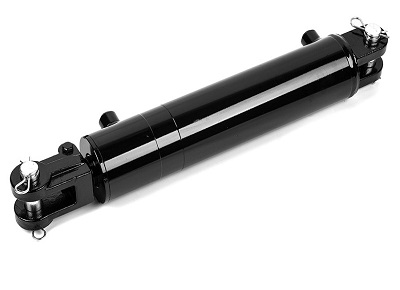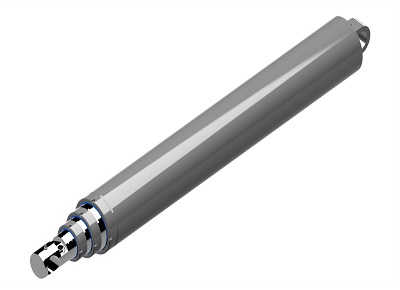Double-acting hydraulic cylinders have two opposing effective areas, which can either be the same or different, and are equipped with two separate ports. By connecting hydraulic oil to either the A or B port, the piston can generate either pulling or pushing force in both directions of movement. Double-acting hydraulic cylinders are used in nearly all applications, making them extremely versatile.
Double-acting hydraulic cylinders are divided into three main types: single-rod hydraulic cylinders, double-rod hydraulic cylinders, and other specialized cylinders.
The majority of hydraulic cylinders in practical use are single-rod hydraulic cylinders, which feature a single piston rod rigidly connected to the piston. The diameter of the piston rod is smaller than that of the piston itself. The name single-rod hydraulic cylinder (also known as a differential cylinder) comes from the difference in effective areas on either side of the piston. The ratio between the piston area and the annular cross-sectional area is represented by a coefficient (denoted as middle).
The maximum transmitted force depends on the piston area during extension and the annular area during retraction, as well as the maximum working pressure. This means that, under the same working pressure, the force during extension is greater than during retraction. The ratio of these forces is given by the coefficient. Due to the differences in areas, the volume varies, which means the stroke speed is inversely proportional to the area.
In a double-rod hydraulic cylinder, the piston has two smaller diameter rods connected rigidly to either end of the piston. The maximum force output depends on the annular areas on both sides of the piston, as well as the maximum working pressure. This means that, under the same working pressure, the force generated in both directions is the same. Since the areas and stroke lengths are equal, the volume and speed are also identical.
In some special cases, China double-rod hydraulic cylinder may have different diameters for the piston rods at both ends, similar to differential cylinders. These cylinders provide varying force and speed depending on the area ratio and stroke length.
When hydraulic oil enters the cylinder through port "A," the piston extends in stages. The lifting pressure depends on the load size and the effective area. Therefore, the piston with the largest effective area extends first, producing the maximum force but with the lowest speed. The last piston to extend produces the smallest force but with the highest speed. This staged extension process is crucial in providing gradual yet powerful force for lifting or pushing operations.
The retraction sequence is determined by the annular area's pressure and the external load size. When port "B" is supplied with pressure oil, the piston with the largest annular area retracts first. This type of hydraulic cylinder can be utilized as a synchronous telescopic hydraulic cylinder, where each piston stage extends and retracts simultaneously, ensuring smooth and efficient operation.
For 4-stage telescopic hydraulic cylinders, like those offered by Hutchin Hydraulic, the multi-stage design allows for higher lifting capabilities in compact spaces, making them ideal for heavy-duty applications where both high force and limited space are factors. For 4-stage telescopic hydraulic cylinders for construction applications, they ensures reliability when handling repetitive heavy loads, from steel beam installation to foundation work.
In hydraulic systems, 4-stage telescopic hydraulic cylinders offer significant advantages for applications requiring high lifting or pushing forces with a compact design. Whether in telescopic or series configurations, these cylinders provide versatility and efficiency for various industrial uses. By understanding the types and characteristics of double-acting hydraulic cylinders, such as single-rod, double-rod, and specialized telescopic or series types, engineers can select the best solutions for their specific needs, ensuring enhanced performance, stability, and power transmission.


